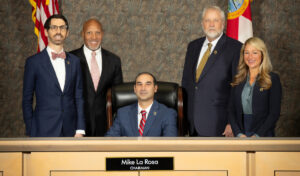Critic argues low-income residents bear the heaviest burden, and a big contributor of carbon emissions gets rewarded.
By Johannes Werner
Original Air Date: December 4, 2024
Host: On Tuesday, a state panel unanimously approved a $1.2 billion storm recovery package for Florida Power & Light. This allows FPL, come January, to hike the average monthly electricity bill by 12 dollars. This kind of ‘largesse’ is pretty much routine, and it will keep the corporation in the black and its investors happy. But one public advocate spoke against approval at the Public Service Commission meeting in Tallahassee. Johannes Werner spoke to Jordan Luebkemann, an attorney representing Florida Rising and Earthjustice.
Johannes Werner: The approval by the Florida Public Service Commission is for a 12-month rate hike, to cover power restoration costs from Hurricanes Debby, Helene and Milton. The governor-appointed commission in the past has regularly approved such costs, which are a temporary add-on to customer bills.

The Florida Public Service Commission
Jordan Luebkemann, an attorney representing Florida Rising — the activist group representing marginalized communities — told the commission that the Public Service Commission almost automatically makes residential customers pay for all repairs, and that’s not right. Luebkemann says that there’s a lack of scrutiny about the numbers FPL and other investor-owned utilities submit to the commission.
Jordan Luebkemann: Generally speaking, the utilities give a number, and it gets approved. Obviously, we need to restore electricity after a storm and that damage needs to be repaired and it costs money. But there does not appear to be a ton of scrutiny in the figures that are given and how those costs are allocated among the customers.
In filing this petition, FPL basically lays out four sets of costs. Three for the storms, Debbie, Milton, and Helene. And then a fourth to replenish a pot of money that is specifically dedicated to storm restoration that was very quickly wiped out. They give an overview of the costs that have been incurred or are expected to be incurred. But the purpose of what was approved yesterday, it’s an interim rate, and so that means they get this approval to add that into bills and to recover that amount of money, and then at the end of the year, once it’s all been recovered, then there will be a hearing that ostensibly will audit how that money was spent and what it was spent on, and also to ensure that they collected the correct amount of money.
JW: In the current approach, low-income resident customers usually bear the heaviest burden, Luebkemann says.
JL: So, our comments yesterday were offered on behalf of Florida Rising, the League of United Latin American Citizens, Florida, which is also known as LULAC, and the Environmental Confederation of Southwest Florida, which is also known as EcoSwift. And these three organizations have missions that have a lot of overlap. One of them, particularly for Florida Rising, is economic justice, and so Florida Rising does not represent exclusively low income members, but it is very concerned with the impact, economically, of its members, who are predominantly black and brown. The economic justice aspect of this is that low income households are disproportionately affected by increases in the cost of things like utilities.

Jordan Luebkemann
And so, yes, in this sense, raising an additional $160 on the average household bill next year just paying for this storm cost is going to impact a low income household more than it’s going to impact a high income household.
JW: Even if the numbers were justified, the underlying principle of full compensation for investor-owned utilities is wrong, he says. Instead, the state should make FPL have “skin in the game”. I asked him what he means by that.
JL: FPL’s profitability is left entirely out of this discussion, and that’s what our comments were offered at the commission to raise the possibility of yesterday that these things should be taken into consideration. So, the way that storm cost recovery works right now, there’s a storm and it costs some amount of money to fix everything after that storm. And the utility brings that total figure to the commission, says, “This is what we need from customers to pay for it.” And the commission says, “Okay,” and then they get to recover that money.
None of that money comes from the utility itself, so the customers of that utility are the ones that have to pay for the cleanup, 100% of the costs, 100% of the time. But it is the decision of utilities to have burned coal for decades, hundreds of years to burn natural gas still to fight the adoption of renewables along the way, even after the science on climate change was ironclad.
And a lot of this resistance came from the fact that it made more money for shareholders not to adopt renewables, when it was first brought to their attention. And so we believe that utilities who are disproportionately, significantly responsible for carbon emissions that drive these stronger storms, right? The carbon emissions that are driving climate change and are ultimately creating these higher costs for recovering from storms. We think that some of that recovery should come out of the profits of those utilities.
JW: Duke Energy Florida and Tampa Electric are also expected to apply for, and get, recovery costs for the storm season.
This has been Johannes Werner, reporting for WSLR News.
WSLR News aims to keep the local community informed with our 1/2 hour local news show, quarterly newspaper and social media feeds. The local news broadcast airs on Wednesdays and Fridays at 6pm.